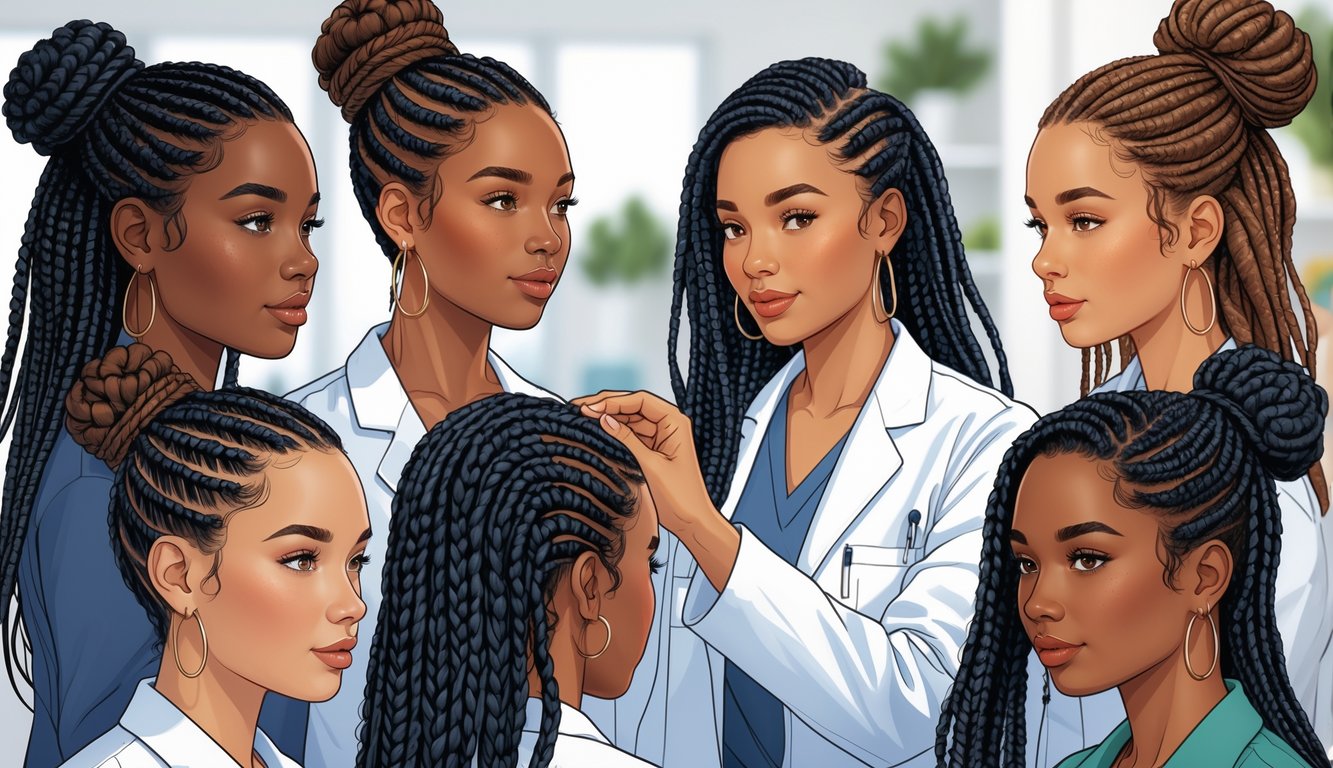
Overview of Popular Braiding Methods
Nobody tells you how fast a “protective” style can become weeks of scalp misery, sticker shock, and those annoying bits of synthetic hair that never come out. Everyone’s shouting “low tension,” but derms I know get the ick just hearing about a bad install. Some braiding methods are just way higher risk, more maintenance, and honestly have terrible reputations with scalp experts.
Box Braids
YouTube makes box braids look easy. They’re not. I’ve watched stylists in big cities and tiny towns section hair, add in synthetic or human hair, and promise four to six weeks of “freedom.” Box braids mean less daily fuss and you can actually wash your scalp. But tiny squares take forever—eight hours, sometimes more. Derms warn about traction alopecia if you see white bulbs at your hairline. Tight edges and headaches? Red flag. And removing them is never quick. Edge control plus buildup equals scalp snowstorm. Not cute. Box braids are not “set it and forget it”—maintenance is real.
Cornrows
Cornrows drive me nuts because they’re so classic, and yet the only way derms give them a pass is if you (or your stylist) skip the death grip. Dr. Kari Williams, trichologist, told me, “Well-installed cornrows can minimize friction and breakage, but only if the partings aren’t razor-thin and the style isn’t left in too long.” Makes sense—cornrows keep hair flat and tucked, no swinging extensions.
Forget your silk scarf at night? Frizz city. Using cornrows as the base for sew-ins or crochet braids? Pull too tight and you ruin the whole “protective” point. Sometimes hair grows in great, sometimes I find weak spots where hair literally bailed after one bad install. Once I called my derm friend in a panic—was tingling normal? (Nope.) She said two weeks is enough. Don’t push it. The scalp needs air, so why do people pile on more product before braiding? No clue. Total mystery.
Twists
Twists. Senegalese, Marley, Havana—supposed to be light and breezy, right? I keep seeing those “jumbo” ones and honestly, I want to drag out my old kitchen scale and just weigh them. They look heavy. Twists are just two sections twisted around each other, not braided, and yeah, they go in faster than box braids. Sometimes I think, “Maybe I’ll try these, save myself some time.” But keeping them neat? That’s a whole new problem. Small twists frizz less but unravel in like, a day. Big ones hang on longer but yank at my scalp so much I start thinking, “Isn’t this the same hairline drama everyone warned me about with braids?” So, what’s the point?
Stylists always want to drown them in mousse. Too much, and you’re sticky for days. And if your twists are too loose? Good luck—they’ll slide out in the shower or just vanish overnight. I had a dream once that I went to work missing three in the back. Woke up, checked—yep, gone. Dermatologists keep saying twists are gentle, but only if you actually prep your hair. Deep condition, oil your scalp, don’t skip it or you’ll regret it. If your hair’s fine, twists are probably better than microbraids for avoiding breakage. Maybe the internet isn’t totally wrong about that, for once.
The Dermatologist-Preferred Braiding Technique

Saw someone with box braids so tight her scalp was shiny and red—looked painful. Dermatologists? Just groan when you bring up those tight styles. They always circle back to this vague “tension-minimized” braiding. I swear, they act like your follicles are paying their rent.
What Sets This Method Apart
I’ve watched stylists crank out French braids and cornrows like it’s nothing, but derms always push for small-to-medium sections. Not those micro or jumbo disasters. Picked this up during three awkward parking lot chats with a derm—she muttered about traction alopecia like it’s the boogeyman.
They’re not yanking in synthetic hair, just neat rows that follow how your hair actually grows. Sometimes they dab on a little moisturizer or scalp oil. One derm literally said, “If the braid hurts, it’s wrong.” Makes sense, but then what was my entire childhood? They’re big on low-manipulation, fewer touch-ups, and banishing those metal-seamed rubber bands that shred your ends. Still see edge control and hair gel mountains everywhere, though.
Benefits for Scalp and Hair Health
Let’s be real: nobody loves slow, gentle braiding. But as I get older, seeing less hair on my pillow matters. Derms rave about less stress on your follicles and fewer tiny scalp tears (not just during consults), which is probably why people who want edges in ten years should care.
It’s weird—by dodging tightness and product build-up, and spacing out touch-ups, I’m not just avoiding pain. Apparently, I’m slowing breakage and the fuzz that pops up along my parts. Gentle, consistent sectioning spreads tension out. The American Academy of Dermatology says that helps avoid hair loss. Human hair, synthetic, whatever—my scalp doesn’t care, it just wants peace. Still, breakage sneaks in like a late bill. And rinsing out old gel? Doesn’t fix anything.
How Linking and Tension Impact Hair Health
Left my sneakers somewhere, coffee’s cold—anyway. Nobody warns you: “protective” styles aren’t magic. Moderate-to-high tension braids and bad linking? Those wreck your hair long-term, and dermatologists can’t even agree on the safest way. So what’s the point?
Best Practices for Minimizing Damage
If you get a “tension headache” after a fresh install, that’s not a good sign. That’s your scalp screaming. I read somewhere—one-third of Black women get traction alopecia, mostly from tight braids or weaves (see this review). Honestly, scarier than losing my wallet.
Braiders love saying “tight is right,” but dermatologists say the opposite. Low-tension, gentle parting, and prepping your scalp matter more. I tried a sleep bonnet that promised “tangle-free linking.” Woke up with a forehead crease and zero results. Biotin serums, silk pillowcases, spacing installs at least two weeks apart—they’re helpful, but if your scalp hurts, you’re already in trouble.
Nobody tells you about the breakage you’ll see weeks later—tiny hairs everywhere, like confetti. Ignore Instagram: if it hurts, unravel it. I check my nape for breakage every time. No rubber bands on ends, ever. A dermatologist once told me, “If it makes you wince, take it out.” Wish I’d listened sooner.
Understanding the Role of Linking in Hair Integrity
This “linking” thing? Everyone’s obsessed. It’s just how one braid connects to another, but mess it up, and your hairline’s toast. You mess up linking, you lose edges. Like cooking eggs with no oil—just asking for a mess.
Asked a dermatologist once: “Each linking point transfers force along the shaft—tension builds up.” That’s not comforting. The direction, angle, and density of linking matter more than what kind of hair you use. Why do YouTube tutorials skip this? Probably not clicky enough. I started keeping a “pain map” after seeing different stylists. Turns out, linking too tight at the root, especially on thin or relaxed hair, sets you back six months. Consistency and careful sectioning—always. Loose at the root, tighter in the middle, never tight at the base, and mix up the angles. Kept my hair on my head longer than any deep conditioner. Random aside: did you know cats can’t taste sweet things? No idea why that came to mind. Maybe hair routines just make me wish for fewer surprises.



